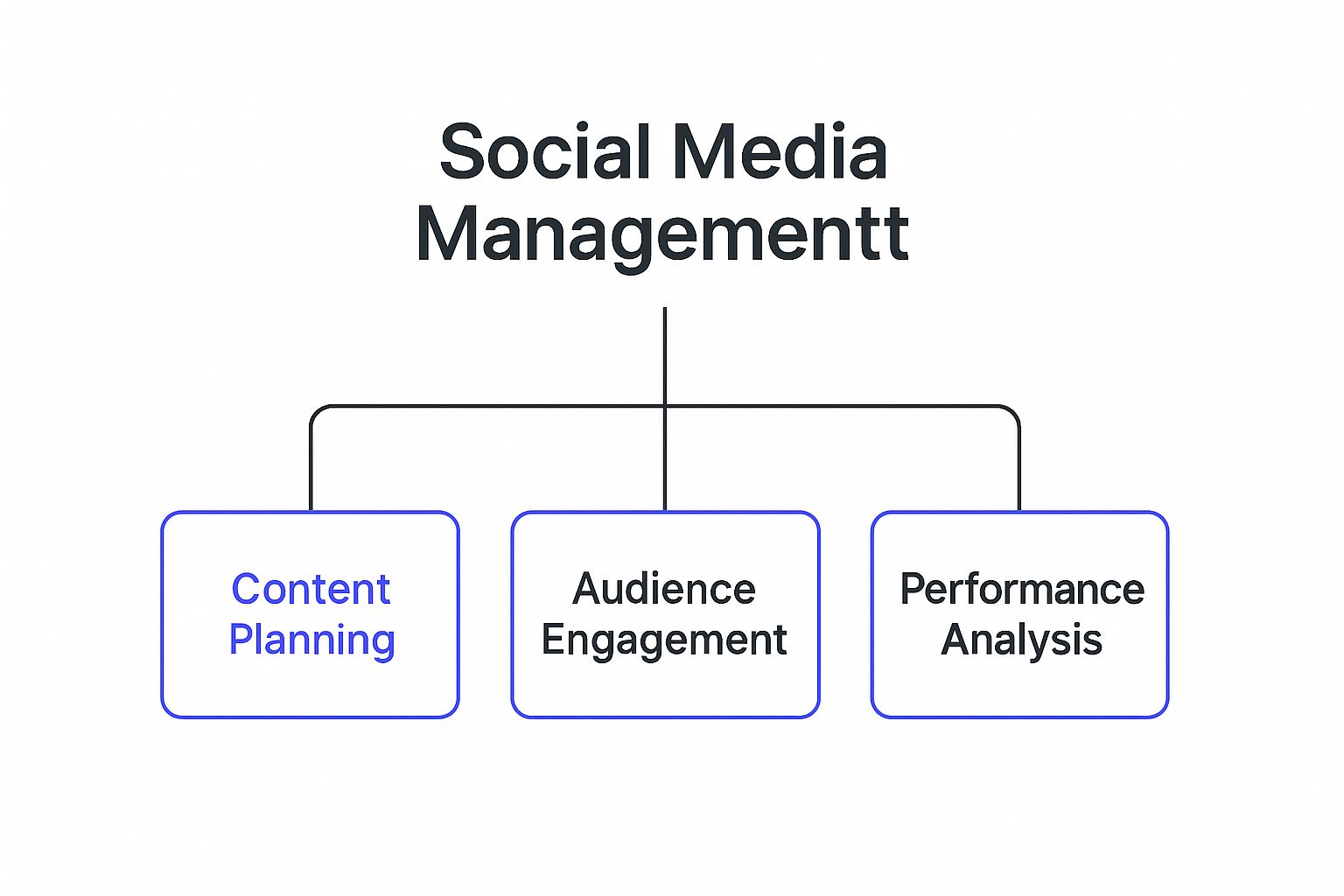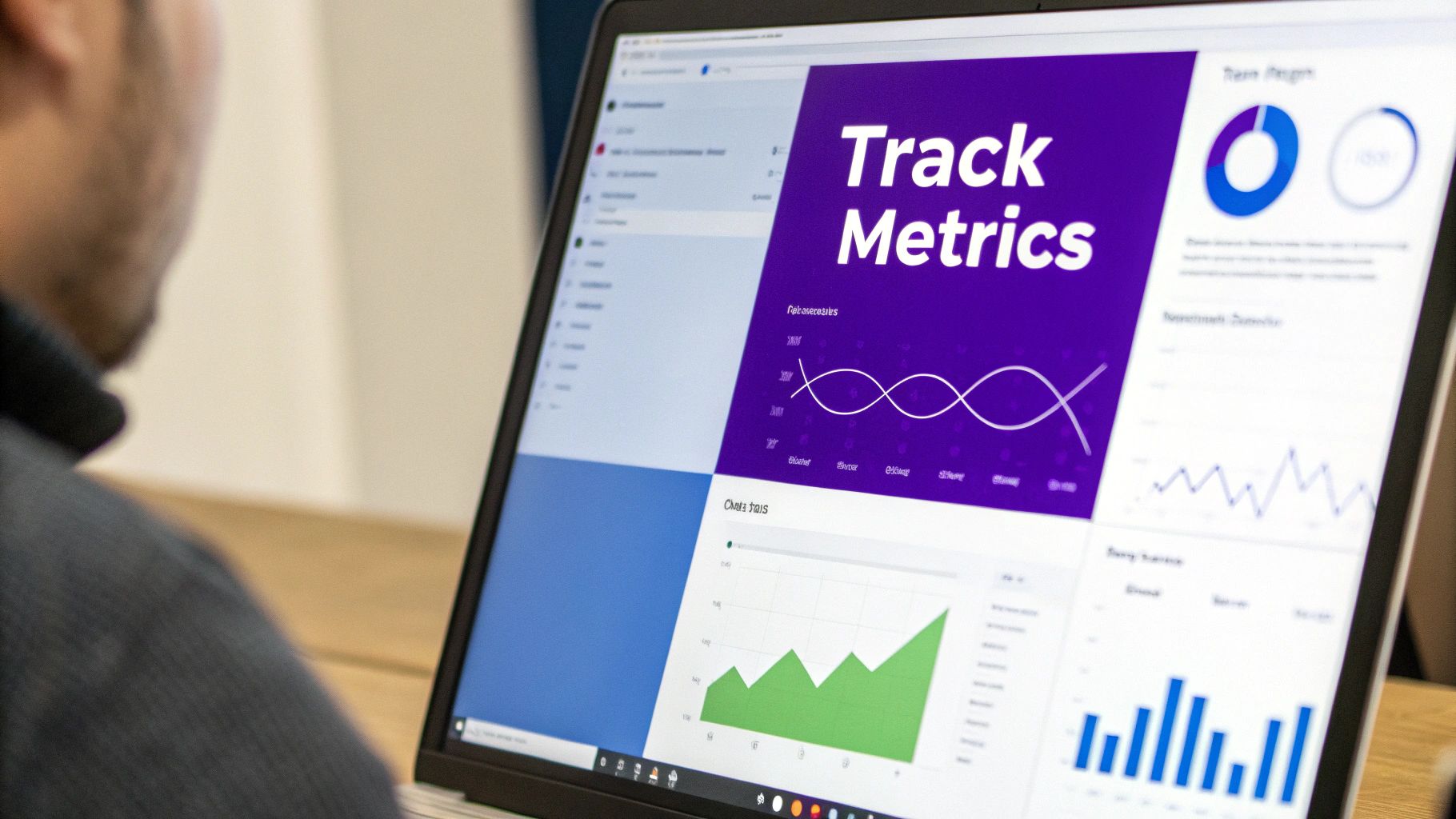Managing Social Media for Small Business: Your Practical Guide
Learn effective strategies for managing social media for small business to boost engagement, sales, and brand awareness. Start today!
Posted by
Let's be honest: treating social media as an afterthought is no longer an option for small businesses. It’s the new main street—the number one way customers find, vet, and connect with brands like yours. Success here isn’t about posting randomly and hoping for the best. It’s about having a real plan.
Why Social Media Is a Must-Have for Small Business
If you still think of social media as just a "nice-to-have," it's time for a reality check. For small businesses trying to get noticed in a crowded market, it's the engine for growth. This is where you build relationships, earn trust, and nudge people toward making a purchase.
And the numbers back this up. A huge 58% of consumers now discover new businesses through social media, blowing past old-school channels. With more than 5.45 billion people scrolling through these platforms, you’re looking at a massive audience just waiting to find what you offer.
The Core Pillars of Social Media Management
Great social media isn't just about posting pretty pictures. It's a structured process built on a few key pillars. If you’re a small business looking to get this right, understanding these fundamentals is the perfect place to start. For a deeper dive, our Ultimate Guide to Social Media Growth Strategies for Small Businesses is packed with frameworks to help you level up.
A winning strategy really comes down to integrating four core functions. Think of it as a continuous cycle.

This workflow shows how managing social media is a loop—you plan, you engage, you analyze, and you repeat. It ensures every action you take has a purpose.
To break this down even further, here's a quick look at the four core components every small business needs to master for social media success. This table breaks down what each pillar means for you.
The Four Pillars of Social Media Management
| Pillar | What It Means for Your Business | Key Action |
|---|---|---|
| Strategy & Planning | Setting clear goals and defining your audience. This is your "why." | Create a content calendar and define key performance indicators (KPIs). |
| Content Creation | Designing posts, videos, and stories that resonate with your followers. | Develop content themes that align with your brand's voice and message. |
| Engagement & Community | Interacting with your audience through comments, DMs, and shares. | Respond to comments and messages promptly to build relationships. |
| Analysis & Reporting | Tracking what works (and what doesn't) to improve your strategy. | Review your analytics weekly to understand top-performing content. |
Getting these four pillars right is what separates the brands that thrive from those that just exist online.
The goal isn't just to be on social media, but to be effective on social media. This means transforming your presence from a simple broadcast channel into a dynamic tool for customer connection and business growth.
Your social media profile is your modern-day storefront. It's often the first impression a potential customer gets. By nailing these basics, you’re not just posting content—you’re building a community, driving traffic, and ultimately, growing your business.
Building a Social Media Strategy That Actually Works
Jumping onto social media without a plan is like setting sail without a map—you’ll be busy, sure, but you probably won’t get where you want to go. A solid strategy is the bedrock of social media for any small business. It’s what turns random posts into a genuine tool for growth.
Frankly, it's the difference between shouting into the void and starting conversations that matter.
The first step is to stop chasing vague goals like "getting more followers." Real success comes from setting clear, measurable objectives. What do you actually want social media to do for your business?

Instead of getting hung up on vanity metrics, tie your efforts to tangible business outcomes. Your goals need to be specific and connected to real results.
- Increase website traffic from social media by 20% in the next quarter.
- Generate 15 qualified leads per month through LinkedIn.
- Boost online sales attributed to Instagram by 10% over the next six months.
- Improve customer response time on Facebook to under one hour.
Goals like these give you a clear target. More importantly, they give you a way to measure whether what you're doing is actually paying off.
Pinpoint Your Ideal Customer
You can't talk to everyone, so don't even try. Effective social media is all about connecting with a specific group of people—the ones most likely to love what you do.
Get granular about your ideal customer. Go beyond their age and location and dig into their habits, their pain points, and what makes them tick. What problems are they trying to solve? What kind of content do they actually find useful or entertaining?
Knowing this is how you create posts that feel personal and relevant, not like another generic ad clogging up their feed. This deep dive is a core part of building a strong social media marketing strategy.
Choose the Right Platforms Wisely
One of the biggest mistakes I see small businesses make is trying to be everywhere at once. It’s a recipe for burnout and stretches your already limited resources way too thin.
Be strategic. Focus your energy where your ideal customers actually hang out.
Don't just follow the crowd. A B2B consultant will find far more success on LinkedIn, while a local bakery should be all-in on Instagram and Facebook, showcasing its delicious creations.
Think about it: a boutique clothing store is going to thrive on visually-driven platforms like Instagram and Pinterest. That’s where they can share high-quality photos of their products, style guides, and behind-the-scenes content. On the flip side, a software company targeting other businesses would get much more value from LinkedIn by sharing industry insights and case studies.
Finally, do a little recon on your competitors. Don’t copy them, but analyze what they're up to. See which platforms they're on, what kind of content gets the most engagement, and where they might be dropping the ball. This analysis often reveals untapped opportunities for your own brand to stand out.
All the strategy in the world won't matter if the content you create falls flat. This is where the rubber meets the road—turning your big plans into actual posts that stop the scroll, get people talking, and genuinely connect with your audience. The real goal isn't just to post; it's to post with a clear purpose.
This means a fundamental shift in mindset. Move away from thinking "What can I sell today?" and start asking, "What value can I provide?" When you consistently give your audience something useful, funny, or inspiring, you build trust. And that trust is what eventually turns casual followers into die-hard customers.

Establish Your Content Pillars
To escape the daily "what on earth do I post today?" panic, you need to set up three to five core content pillars. Think of these as the main highways your brand's conversation will travel on. A good mix keeps your feed from getting stale and makes sure you're delivering balanced value.
Let’s say you run a local coffee shop. Your pillars might look something like this:
- Educational: Think "How to Brew the Perfect Pour-Over at Home."
- Entertaining: Maybe some "Funny Latte Art Fails" or a spotlight on your quirky barista.
- Community-Focused: Share photos from customers or highlight another local business you love.
- Promotional: And of course, "This Week's Special: The Lavender Honey Latte."
This framework ensures you're not just a walking advertisement. You’re actually building a brand personality that people want to be around.
Embrace the Power of Video
If you're going to prioritize one format, make it video. It’s not a trend anymore; it's a core part of how we all consume content online. Short-form videos—like Instagram Reels and TikToks—are gold for showing off products, sharing quick tips, or giving a peek behind the curtain of your business.
The numbers don't lie. Research shows that 78% of users would rather learn about new products by watching a short video. And with 93% of marketers planning to ramp up their social media game in 2025, leaning into video is how you stay ahead.
Pro-Tip: Forget the professional film crew. Your smartphone is more than enough to get started. Just focus on good lighting, clear audio, and authentic storytelling. People value realness over high-production perfection every single time.
Write Captions That Spark Conversation
Your visual is the hook, but your caption is what reels them in for a conversation. A great caption doesn't just describe what's in the picture; it invites your audience to chime in.
Instead of just stating facts, try asking open-ended questions. Share a personal story that connects to your product. You could even create a "fill-in-the-blank" post that’s easy for people to comment on. The goal is to make your followers feel like they’re part of a community, not just watching from the sidelines.
Let Your Customers Create for You
One of the most potent tools you have is user-generated content (UGC). When a happy customer posts a photo or video with your product, it’s the most authentic, trustworthy marketing you could ask for—and you didn't even have to create it.
Here’s how to encourage it:
- Create a unique brand hashtag and promote it everywhere.
- Run a contest where people submit photos for a chance to win something cool.
- Regularly feature customer content on your feed (just make sure you ask for permission first!).
This does more than just fill your content calendar. It builds a powerful sense of community by making your customers feel seen and appreciated. If you need a little help crafting stunning visuals, our guide on the best social media content creation tools is a great place to start. And to keep your brand looking sharp and consistent, using pre-made social media design templates can be a real game-changer.
Let's be honest: the daily grind of posting on social media can feel less like a growth strategy and more like a hamster wheel. For most small business owners, what starts as an exciting way to connect with customers quickly turns into a draining, relentless chore.
The answer isn't to post less. It's to work smarter. You need a system.
This system revolves around two simple but powerful ideas: batch creation and strategic scheduling. Instead of waking up every morning thinking, "What on earth am I going to post today?", you carve out a dedicated block of time—maybe a couple of hours on a Monday—to create everything for the week ahead.
It's a small shift, but it’s a total game-changer. It lets you get into a creative groove, keeps your brand voice consistent, and ensures you're actually posting a healthy mix of content, all without the daily panic.
Get Friendly with a Content Calendar
Your new best friend in this process is a content calendar. This doesn't need to be some fancy, expensive software. A simple spreadsheet works just fine. The point is to map out your posts ahead of time, giving you a clear, bird's-eye view of what’s coming up.
A good calendar should track a few key things for each post:
- The exact date and time it will go live.
- The social platform it's for (since you'll want to tailor it).
- The visual you're using—the image, video, or graphic.
- The copy itself, including the caption and all your hashtags.
This level of organization is what stops the last-minute scramble. It also ensures your social media activity actually supports your real-world business goals, like a big sale you have coming up or a new product you're about to launch.
When you plan ahead, you stop being reactive and start being proactive. You’re no longer a slave to the daily content machine; you're the one in the driver's seat, making sure every single post has a purpose.
Put Your Content on Autopilot with the Right Tools
Once your content is created and neatly organized in your calendar, scheduling tools are what make the magic happen. Platforms like Buffer or Hootsuite are designed for this. They act as a single command center for all your social accounts.
You can log in once, upload everything for the week, and tell the tool exactly when to publish each post.
Imagine getting all your social media work done for the week by Monday afternoon. Seriously. The rest of your time is freed up for the things automation can't do—like actually talking to your customers, replying to comments, and building real relationships. That's where the real value is. If you want to get into the nitty-gritty, you can learn more about how to automate social media posts and win back your time.
Ultimately, these tools take the repetitive, manual task of posting off your plate. This combo of batching, calendaring, and scheduling is what transforms social media from an overwhelming burden into a manageable—and genuinely effective—strategy for growing your business.
How to Analyze Your Performance and Grow Smarter
Let’s be honest: posting great content is only half the battle. The other, arguably more important half, is figuring out what’s actually working.
Without looking at your data, you’re just guessing. You're throwing content at the wall and hoping something sticks. It’s time to stop flying blind and start focusing on the numbers that will actually help you grow.
And no, I'm not talking about vanity metrics like your total follower count. A huge audience is nice, but it means nothing if they aren't engaging with you or, better yet, becoming customers. We need to measure the actions that signal genuine interest.
Key Metrics That Matter More Than Likes
Instead of getting lost in a sea of data, let’s zoom in on a few core metrics that tell the real story of your performance. These numbers show you how deeply your audience is connecting with your content and whether they're taking that all-important next step.
Start tracking these:
- Engagement Rate: This is the big one. It's the percentage of your audience that actually interacts with your posts—through likes, comments, shares, and saves. A high engagement rate on a smaller, dedicated account is 100% more valuable than a low one on a massive account with passive followers.
- Click-Through Rate (CTR): When you share a link to your latest blog post or a product page, how many people are actually clicking it? Your CTR tells you if your calls-to-action are compelling enough to get people off of social media and onto your own turf.
- Conversions: This is the ultimate goal, right? Conversions track how many people completed a desired action—like signing up for your newsletter or making a purchase—after clicking through from a social post. This is where your ROI becomes crystal clear.
Focusing on these three metrics gives you a much more accurate picture of what's working and what's a waste of time.
It's not about reaching everyone; it's about reaching the right people and inspiring them to act. Strong engagement and a healthy click-through rate are the signs you're building a real community, not just collecting digital ghosts.
Creating a Simple Monthly Check-In
You don’t need some ridiculously complex, multi-tabbed spreadsheet for this. A simple monthly check-in is all it takes to keep your strategy sharp and effective.
Just set aside an hour at the end of each month. Open up the built-in analytics on Facebook and Instagram and start looking for patterns.
What were your top-performing posts from the last 30 days? Jot down the format (was it a video, a carousel, a single image?), the topic, and the style of the caption. Did posts published on a Tuesday morning consistently get more traction?
This simple review process gives you concrete, data-backed insights to guide your next month's content.
Maybe you'll discover that your silly behind-the-scenes videos get double the engagement of your polished product shots. Boom. That’s a clear signal to create more of that stuff. This little routine is what transforms your social media from guesswork into a smart, adaptive strategy that actually gets better over time.
Budgeting for Social Media Without Breaking the Bank
Let's talk about the social media budget. For most small business owners, it feels like throwing a number at a wall and hoping it sticks. But it doesn't have to be a total guessing game. Getting a handle on your social media spending is all about creating a practical financial roadmap, one that lets you invest wisely without just draining your bank account.
The first step is understanding what things actually cost. Your expenses can swing wildly depending on what you’re trying to achieve. Are you a one-person show creating all the content yourself? Or are you looking to hire a freelancer, run ad campaigns, or sign up for a few powerful tools? Each path comes with a very different price tag.

Breaking Down the Common Costs
So, where does the money actually go? When you start mapping out your presence, your expenses will generally fall into three main buckets.
- Content Creation: This is everything that goes into making your posts. Think subscriptions for tools like Canva Pro, hiring a freelance photographer for a product shoot, or even paying a videographer for a day.
- Management & Labor: This is the cost of time—either your own or someone you pay to run the show. This could be a part-time social media manager, a freelancer you hire for a few hours a week, or a small agency.
- Advertising Spend: This is the cash you put directly into platforms like Facebook or Instagram to boost your best posts or run super-targeted ad campaigns to find new customers.
Industry numbers show just how much these costs can vary. Basic social media management can run anywhere from $500 to $5,000 per month. If you start working with content creators, you might pay nano-influencers $40 to $150 per post, while a mid-tier creator could ask for around $350. Sprout Social has some great data on social media management costs if you want to dig deeper.
How to Create a Budget That Grows With You
Here’s the secret: your budget needs to be scalable. You absolutely do not need to dive in with a massive four-figure monthly spend right out of the gate. The smartest approach is to start small, watch your results like a hawk, and then double down on what’s actually working.
Your first social media budget isn’t a permanent commitment; it’s an experiment. The real goal is to prove you can get a return on a small scale before you pour more resources in.
Kick things off by allocating a modest amount you’re genuinely comfortable with. Right now, your job is to prioritize the activities that have the highest potential for return. For most small businesses, that means starting with high-quality, organic content.
Once you see which posts are resonating with your audience and driving clicks, then you can strategically sprinkle in a small ad budget to amplify that winning content.
This "test, measure, scale" approach stops you from burning cash on strategies that fall flat. It ensures every single dollar you eventually spend is backed by real data, turning your social media from just another expense into a powerful, revenue-driving machine.
A Few Common Questions We Hear All the Time
Alright, let's wrap this up by hitting a few of the most common questions that pop up when you're in the trenches of social media management. Getting these sorted will help you build a solid strategy and move forward with a lot more confidence.
"Seriously, How Often Should I Be Posting?"
Everyone asks this, but there's no magic number. The real goal is consistency, not just volume. Forget the pressure to post every single day if it means the quality drops. That's a losing game.
For platforms like Instagram and Facebook, a great starting point is 3-5 high-quality posts per week. On a more professional network like LinkedIn, 2-3 solid posts a week is often more than enough to stay on people's radar.
The trick is to pay attention to what your audience responds to. Let the data tell you what's working and adjust from there.
Look, posting five amazing pieces of content will always beat posting seven mediocre ones. Quality builds community; quantity just creates noise.
"What’s the Real Difference Between Organic and Paid Social?"
This is a big one. Nailing this down is key to figuring out where to put your time and your money.
- Organic Social: This is all the free stuff—your regular posts, your stories, the replies you write to comments. It’s how you build a genuine community and show people who you are. It’s the long game, focused on loyalty.
- Paid Social: This is when you put money behind your content, running targeted ads to reach people who don't follow you yet. It's an incredible tool for getting new leads and driving sales, fast.
A killer strategy almost always uses a mix of both. Use organic to connect with the people who already love you, and use paid to go find more of them.
"Should I Do This Myself or Hire Someone?"
Lots of small business owners start out running their own social media, and that's perfectly fine. When you're just getting started, it's often the most practical option, especially with tools that help you batch and schedule your content ahead of time.
But as your business grows, you'll probably find your time is better spent somewhere else. That's the point where bringing in a freelancer or a part-time social media manager makes a ton of sense. It really comes down to balancing your time, your budget, and how comfortable you are managing it all yourself.
Ready to take control of your social media and customer testimonials without the stress? EndorseFlow combines everything you need into one simple platform. Start your 14-day risk-free trial today!